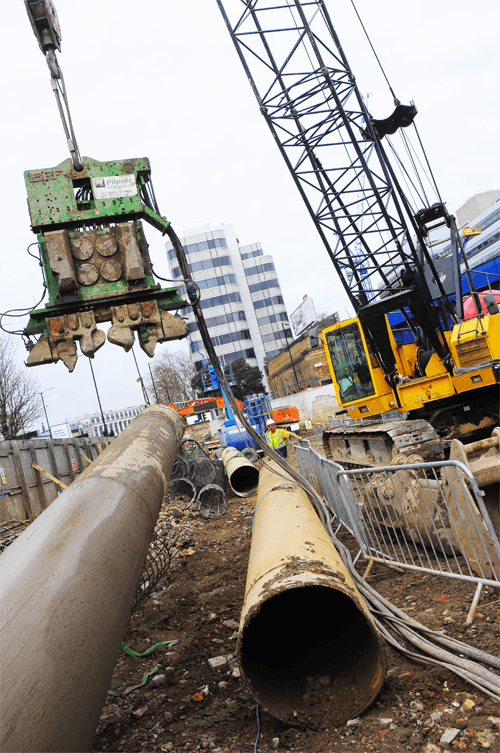Miller Piling needed to install a total of 1500 concrete piles on two major high profile projects in the centre of London, one residential and one mixed use. Although in close proximity to each other, both projects had different and equally challenging ground conditions to contend with. Having worked with Piletec previously on a number of projects, Miller chose to hire two Free Suspended Vibratory piling hammers.
Project 1 - Tower Bridge
One Tower Bridge is located on the site of a derelict coach-park between the GLA Headquarters and Tower Bridge on the South bank of the river Thames. Miller Piling were appointed to design and construct a combination of a continuous flight auger (CFA) and rotary bored piles for the formation of a basement and new residential development, comprising 374 new apartments for Berkley Homes. The development will also include a cultural centre, retail facilities and a health spa.
The Challenges
The location, while highly sought-after as an address, had less than ideal ground conditions, being very poor and variable soil down to 10 m with London Clay beneath. Consequently, Miller Piling were required to install a series of reinforced concrete piles in diameters of 750mm to 1,200mm to a depth of up to 28m. They also had to overcome the risk of the ground slumping during the installation of the rotary bored pile sockets.
The Solution
Miller opted for Piletec’s ICE 3120 High Frequency Vibratory Piling Hammer to install the temporary steel pile casings.
Normally we’d bore down and then lower the casing into the ground before placing the reinforcement and pouring concrete, but because the ground was so bad that had we done it in the usual way, debris and water would have fallen into the hole before the casings were placed. So we used the Piletec hammer to insert the casings before we drilled them out, and as some of the casings are up to 12m long we used the hammer suspended from a crane.
James Haywood, Regional Manager - Miller Piling
By using this method Miller were able to install and use
the ICE 3120 to lift the casings out of the ground before
the concrete cured Mr. Haywood added “ Without the Vibratory hammer, the process would of been slow and laborious."
Project 2 - Blackfriars Road
 The second Miller project was a new 30 storey, mixed-use development for Great Ropemaker Properties, a joint venture between Great Portland Estates and Ropemaker Properties.
The second Miller project was a new 30 storey, mixed-use development for Great Ropemaker Properties, a joint venture between Great Portland Estates and Ropemaker Properties.
The site, located on the South Bank of the Thames close to Blackfriars Bridge is bounded on one side by the Victorian brick viaduct which carries the overground and Thameslink railway lines into Blackfriars Station via the bridge.
The Challenges
Although the project at Tower Bridge was larger, Blackfriars was more challenging due to the close proximity of the viaduct carrying a busy railway past the site. Here, they needed to eliminate the risk of structural damage together with minimising noise nuisance.
On this site Miller needed to install 280 piles to form a ‘secant’ piled basement box together with 168 reinforced concrete bored bearing piles of 750mm diameter along the line of the viaduct.
Due to poor, variable ground conditions in the upper layers, meant that the foundations had to go deep; the concrete bearing piles ranged in length from 20m to 42m.
The Solution
Temporary steel casings were driven down to approximately 12m before the piles could be bored into the dry stable clay found at depth. Driving these casings so close to the viaduct with a traditional impact hammer carried the risk of structural damage, as well as creating a noise nuisance to nearby businesses. To avoid these risks Miller chose a Free suspended Piletec ICE 18RF, Resonance Free, Vibratory hammer.
Specifically designed for resonance free operation, the ICE 18RF can be used closer to buildings than conventional Vibratory hammers. This range has all the advantages of the high frequency range, but in addition, the eccentric moment can be switched off during start up and switched back on once the machine has reached its optimum operating frequency. In this way harmful resonances can be avoided. The amplitude can also be adjusted between zero and 100% so that the maximum permitted vibration level or peak particle velocity is not exceeded.
We use Piletec a lot for hammers, the equipment is good and the service is very prompt, together with good technical back up. Using Piletec’s vibrating hammers on these two projects helped to speed up the process and ensure that Miller were able to remain on schedule.
James Haywood, Regional Manager - Miller Piling
Download PDF